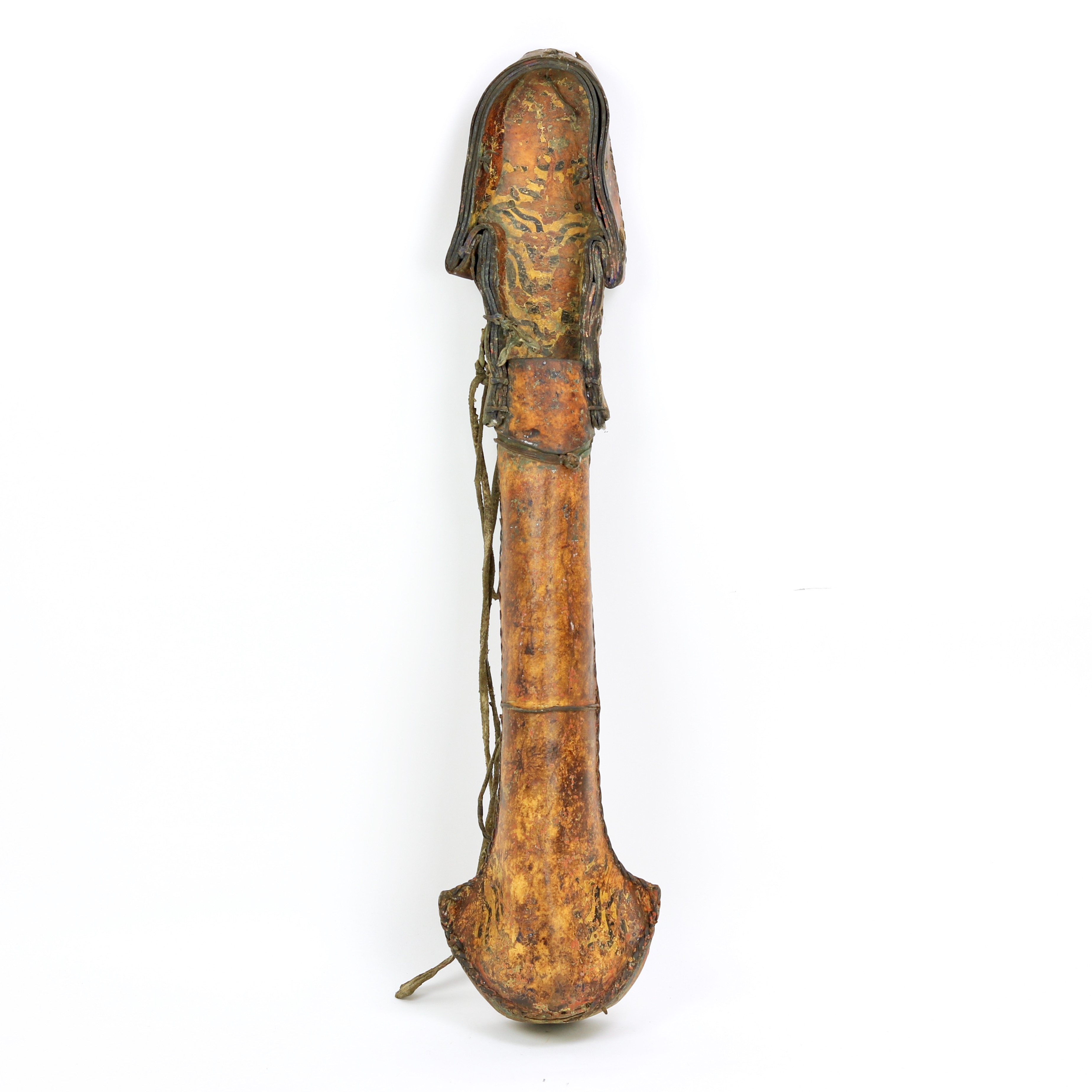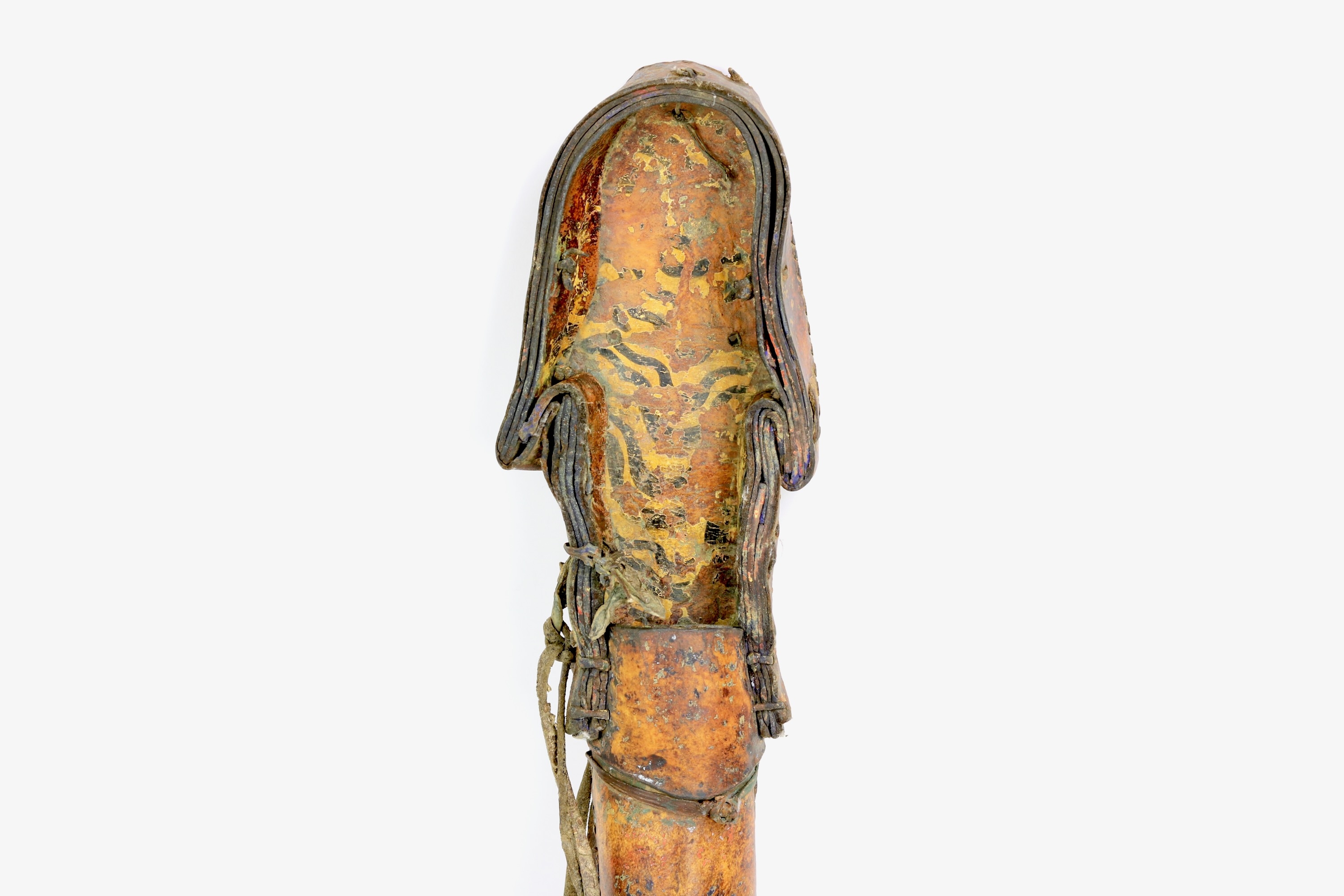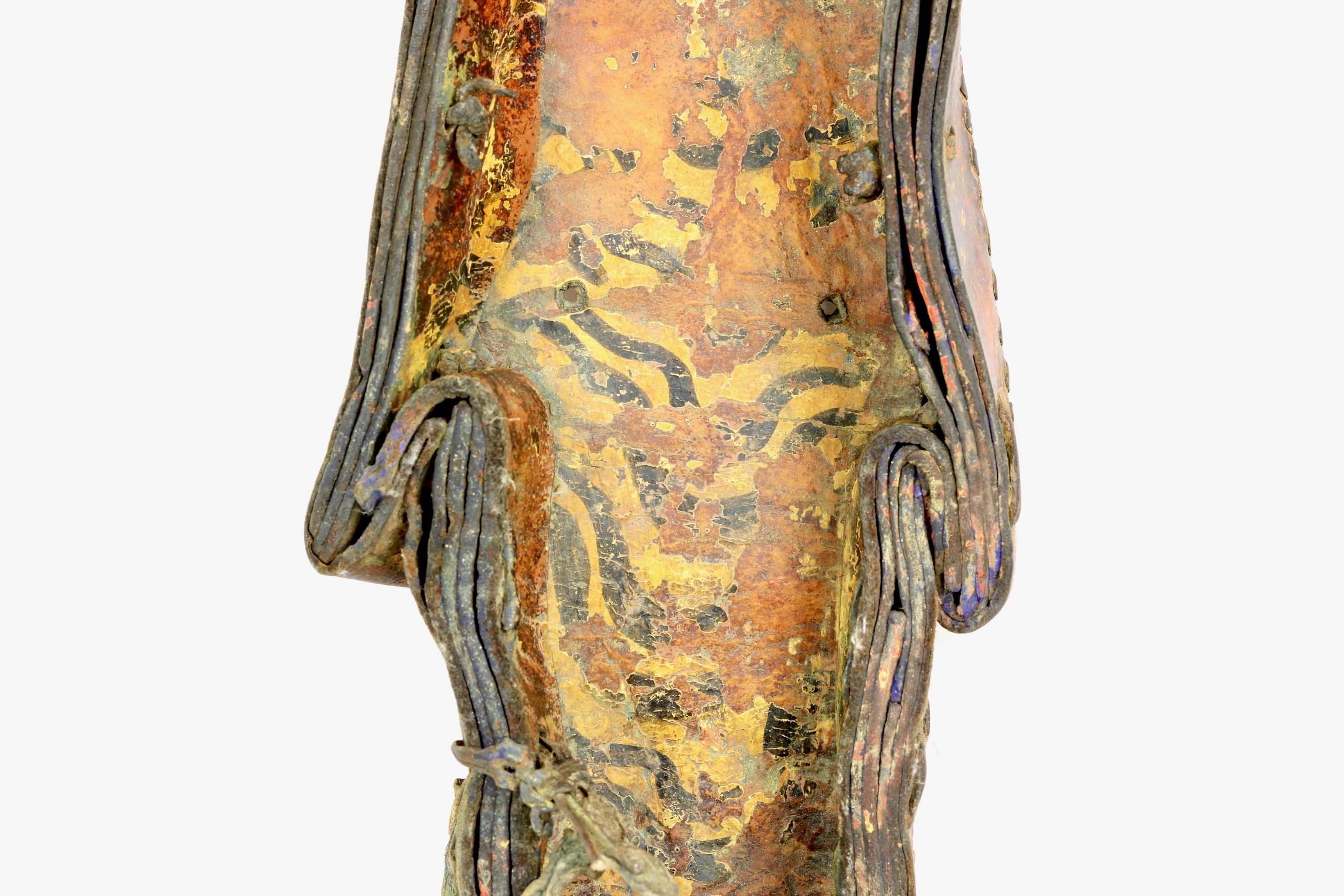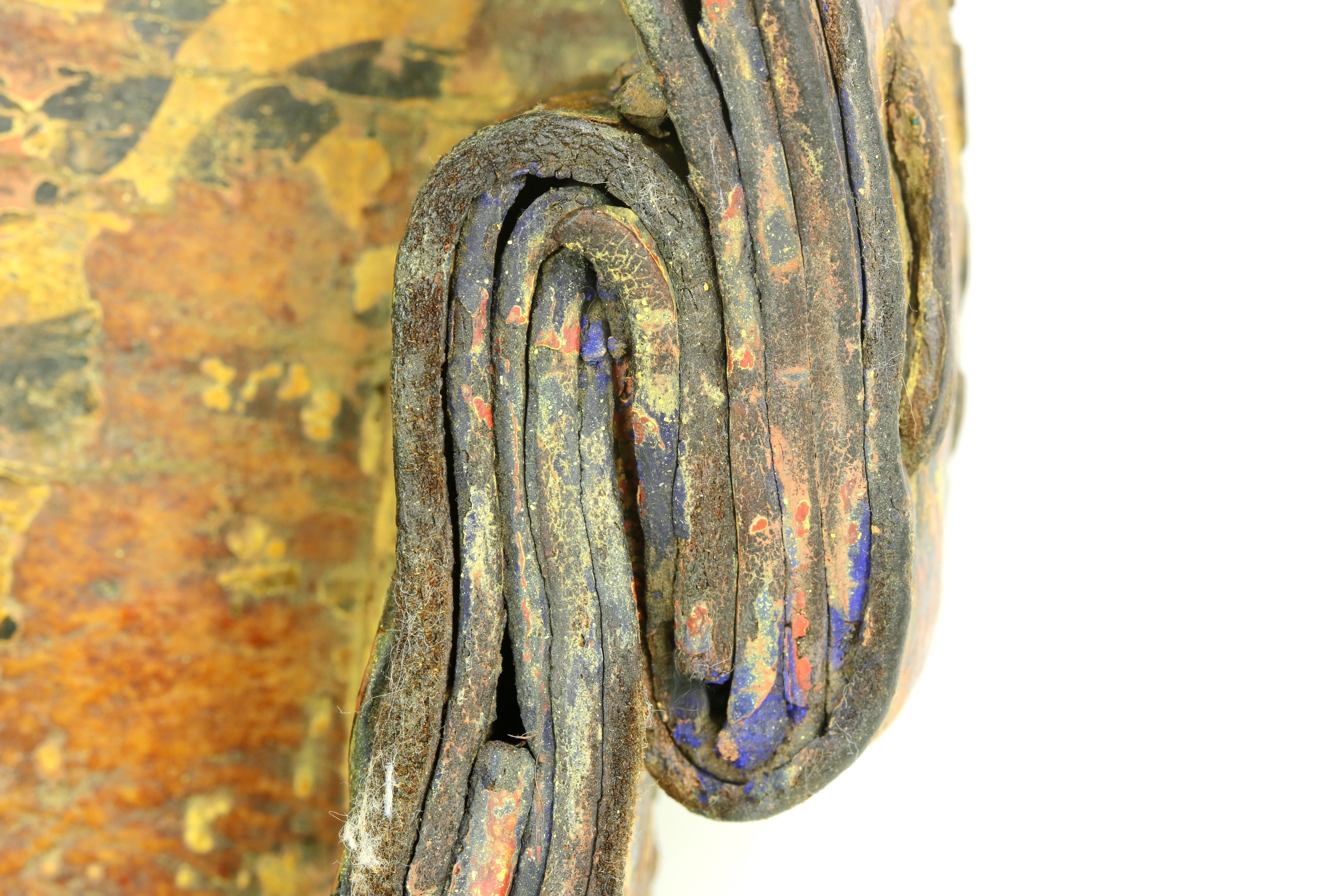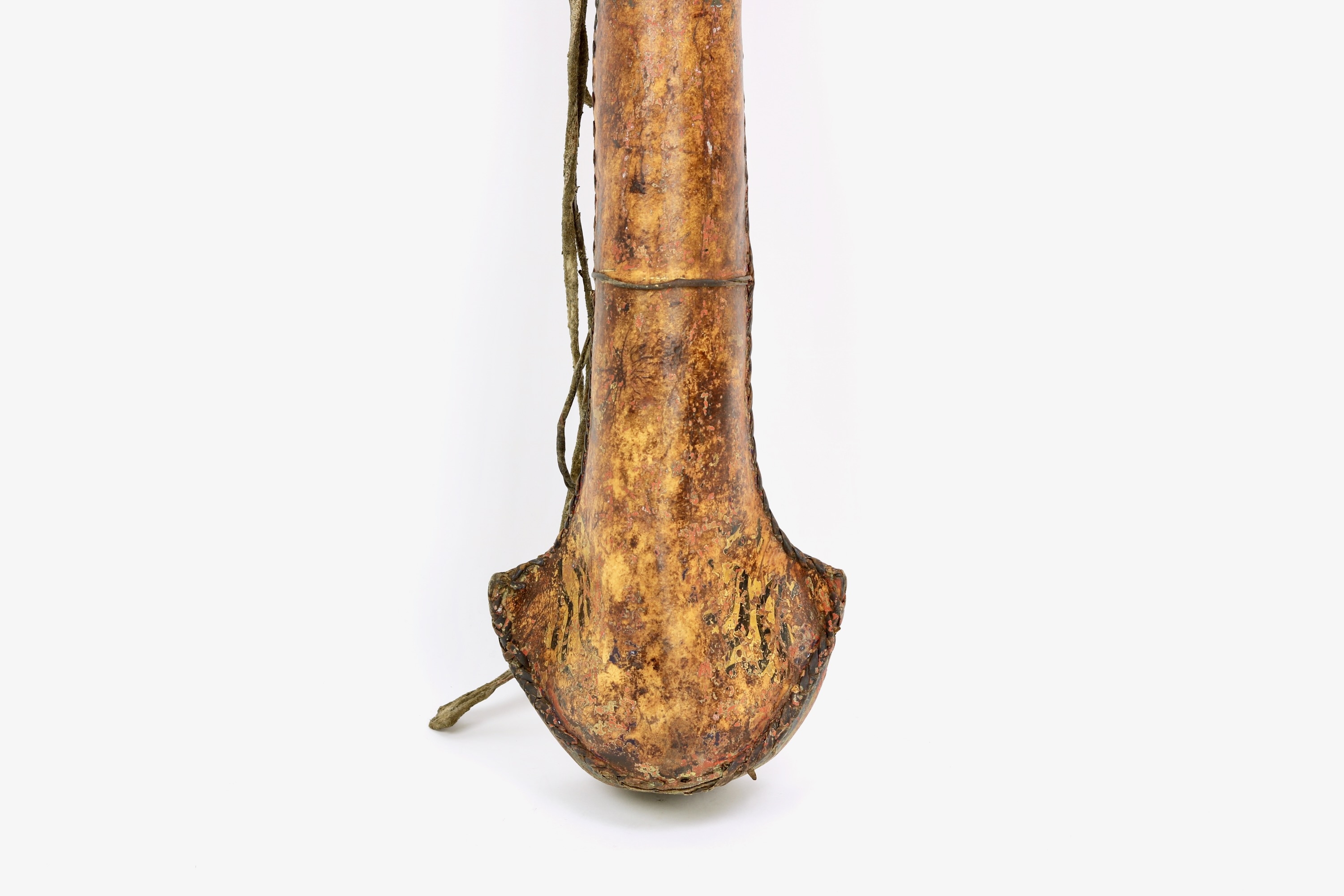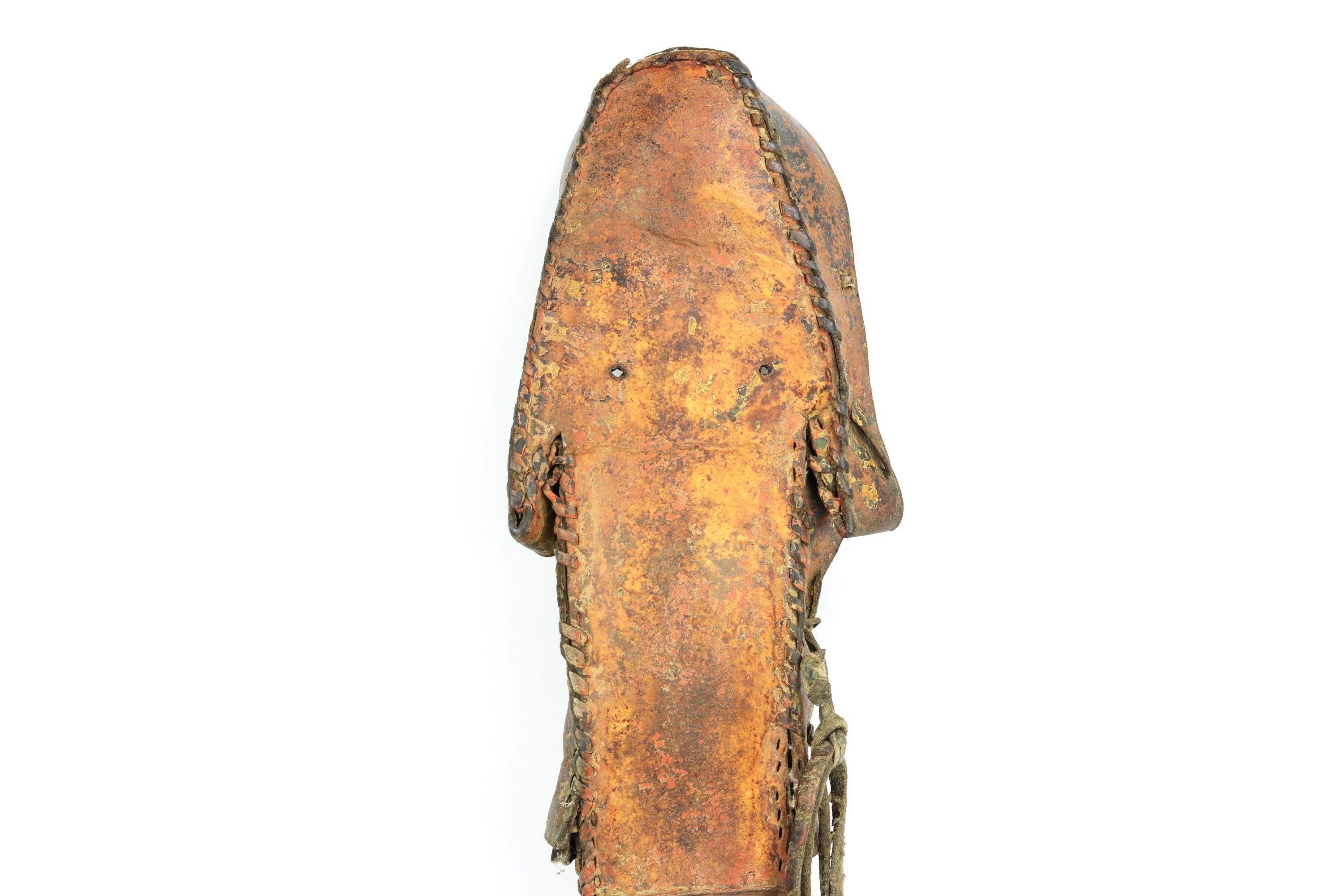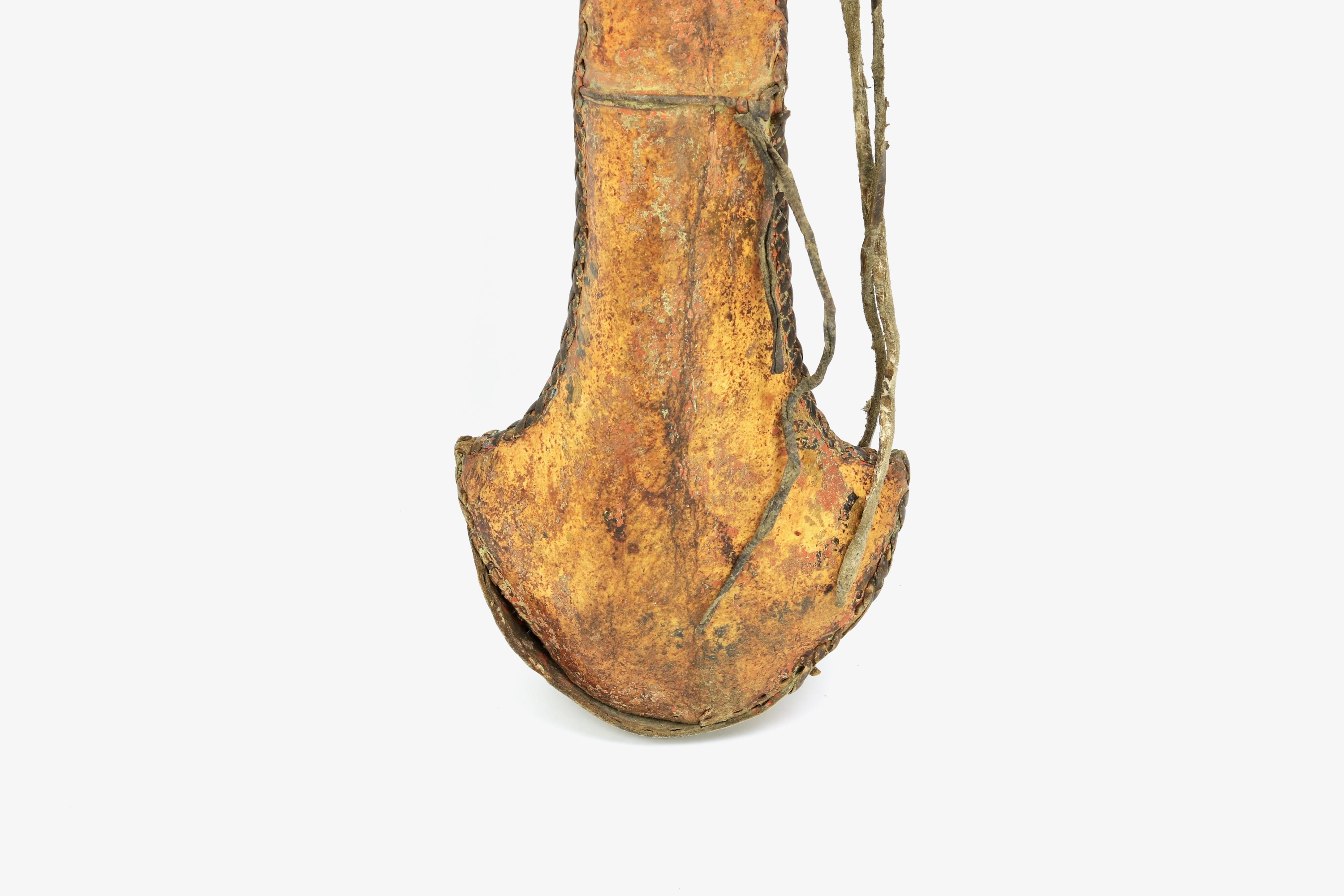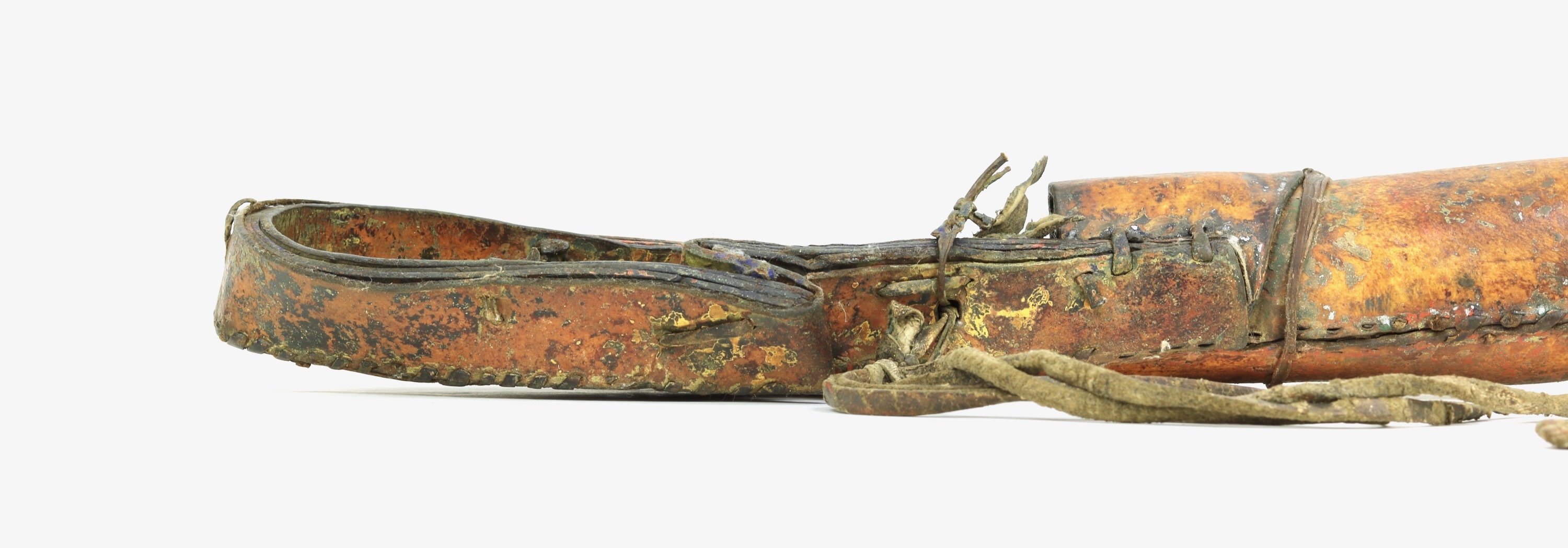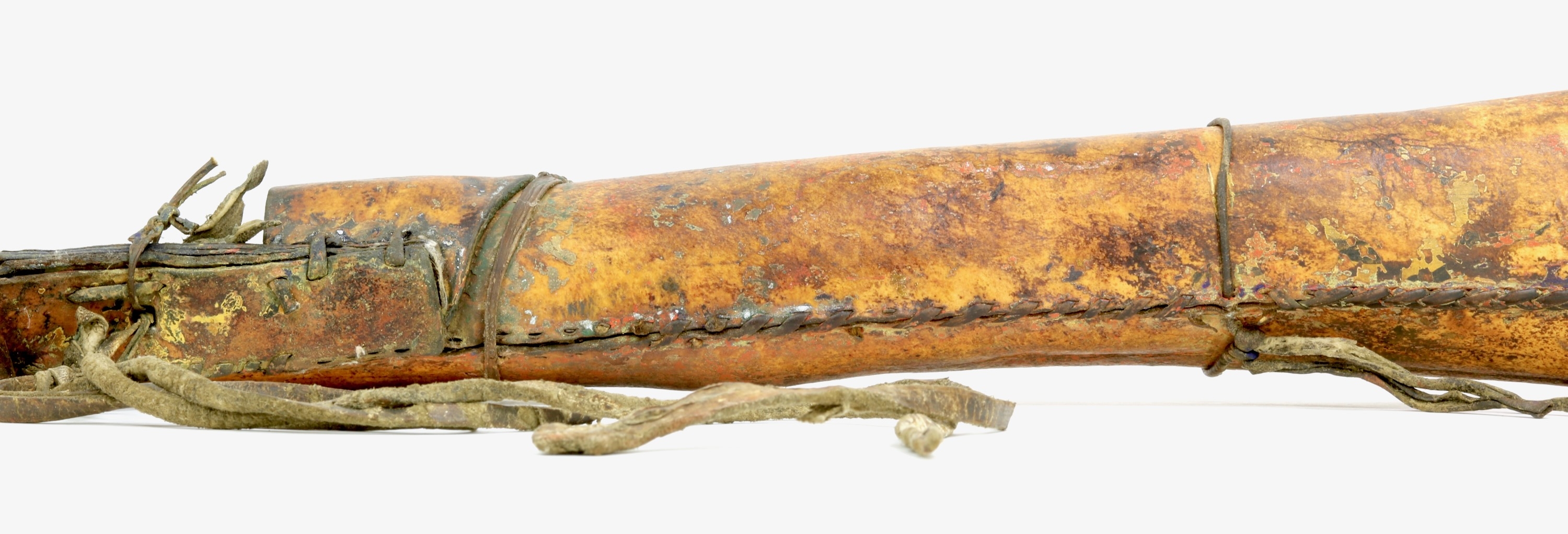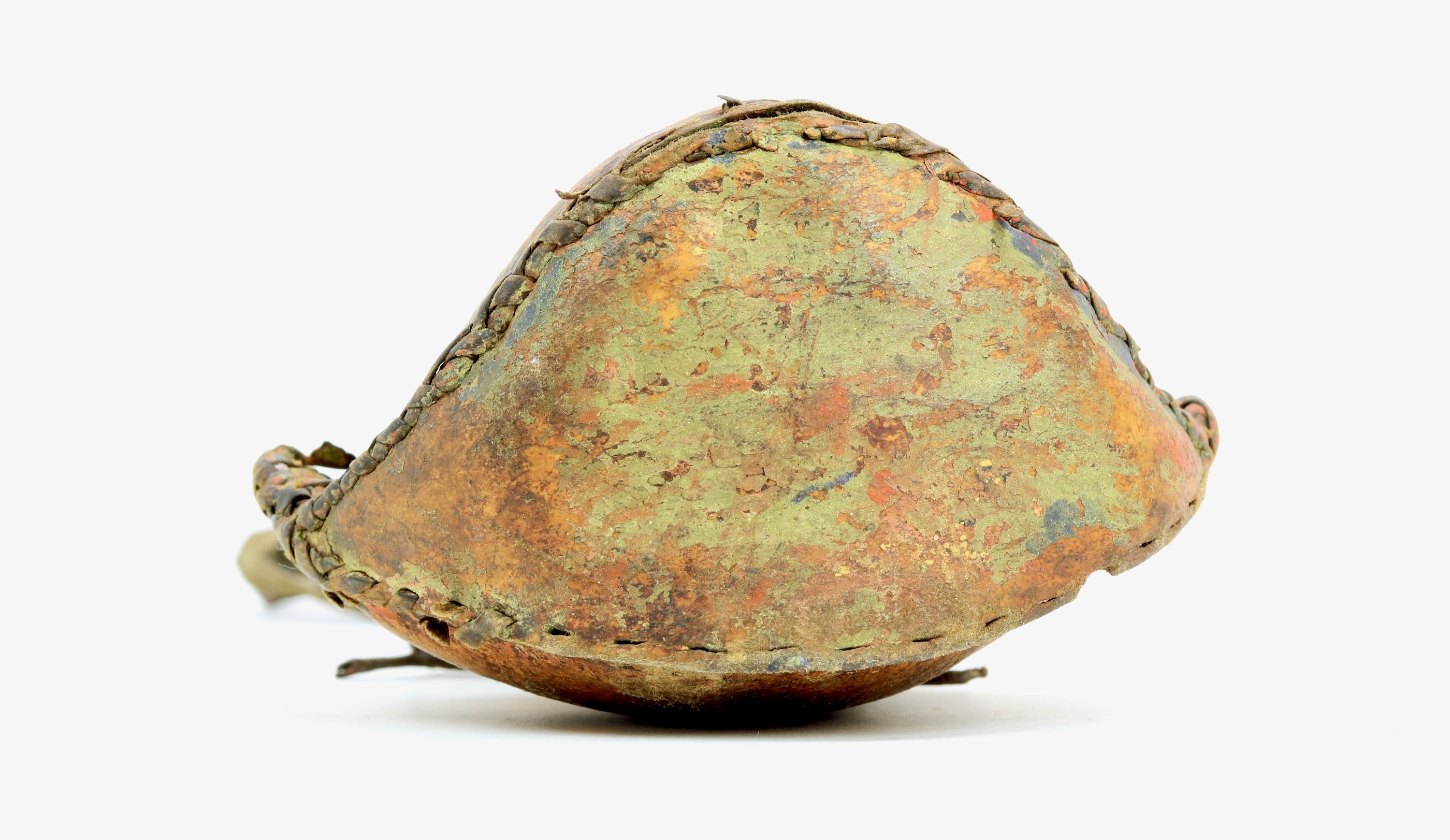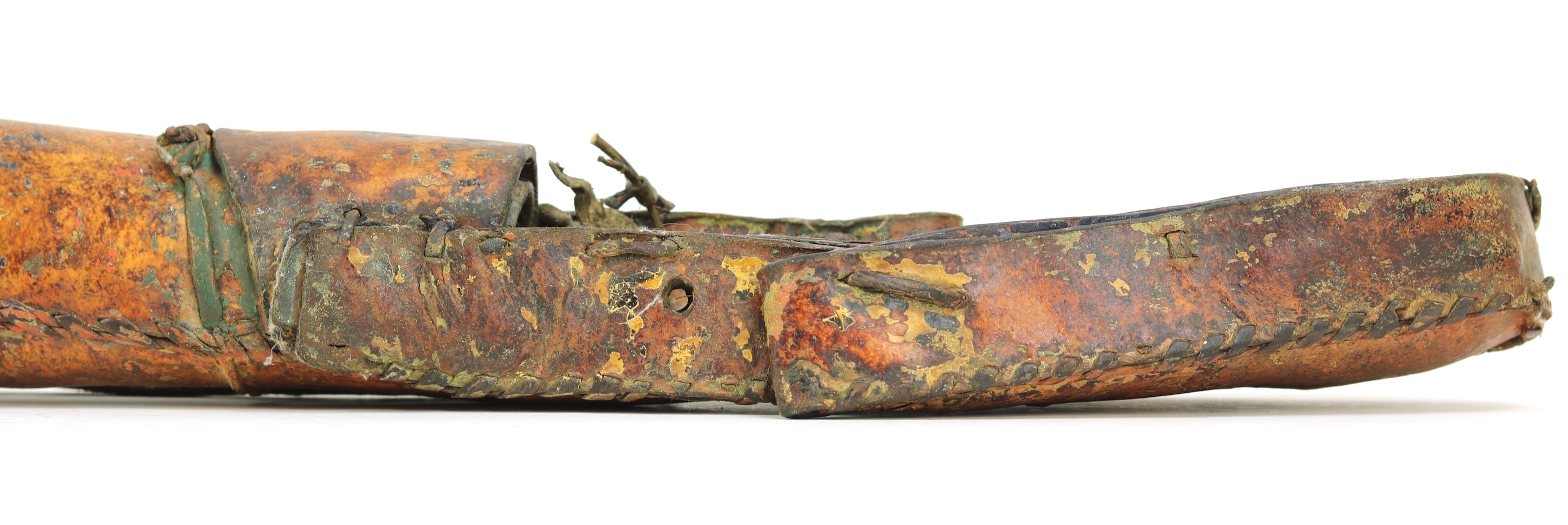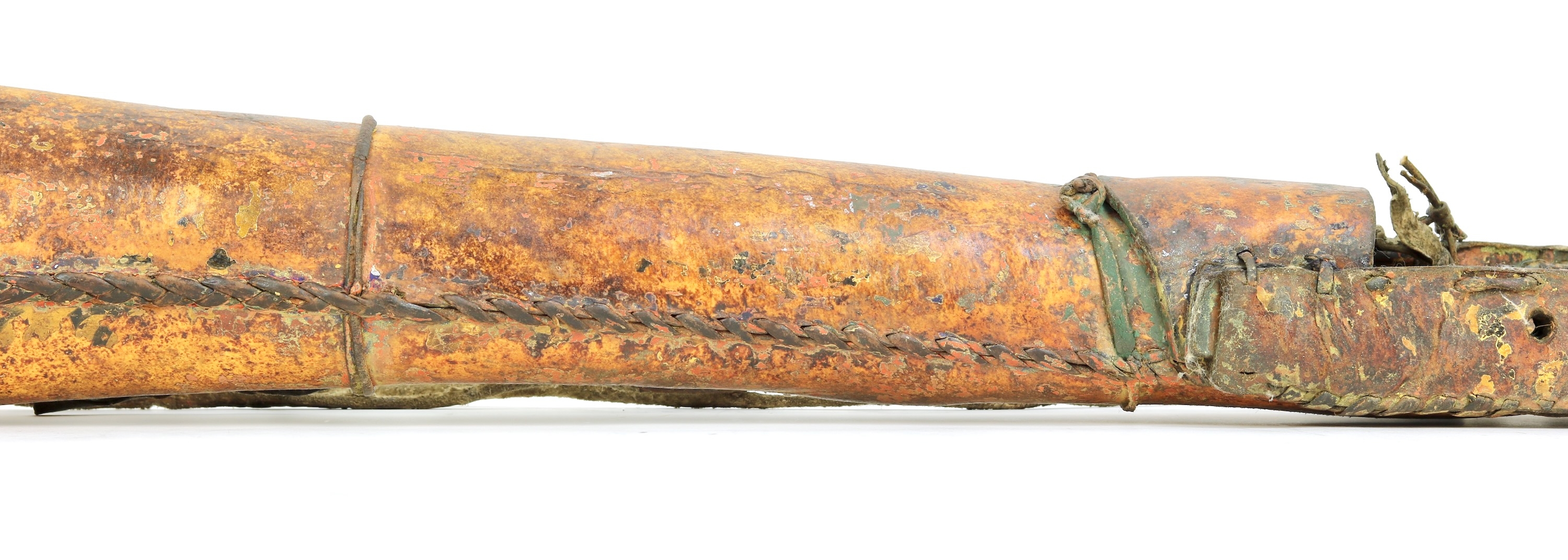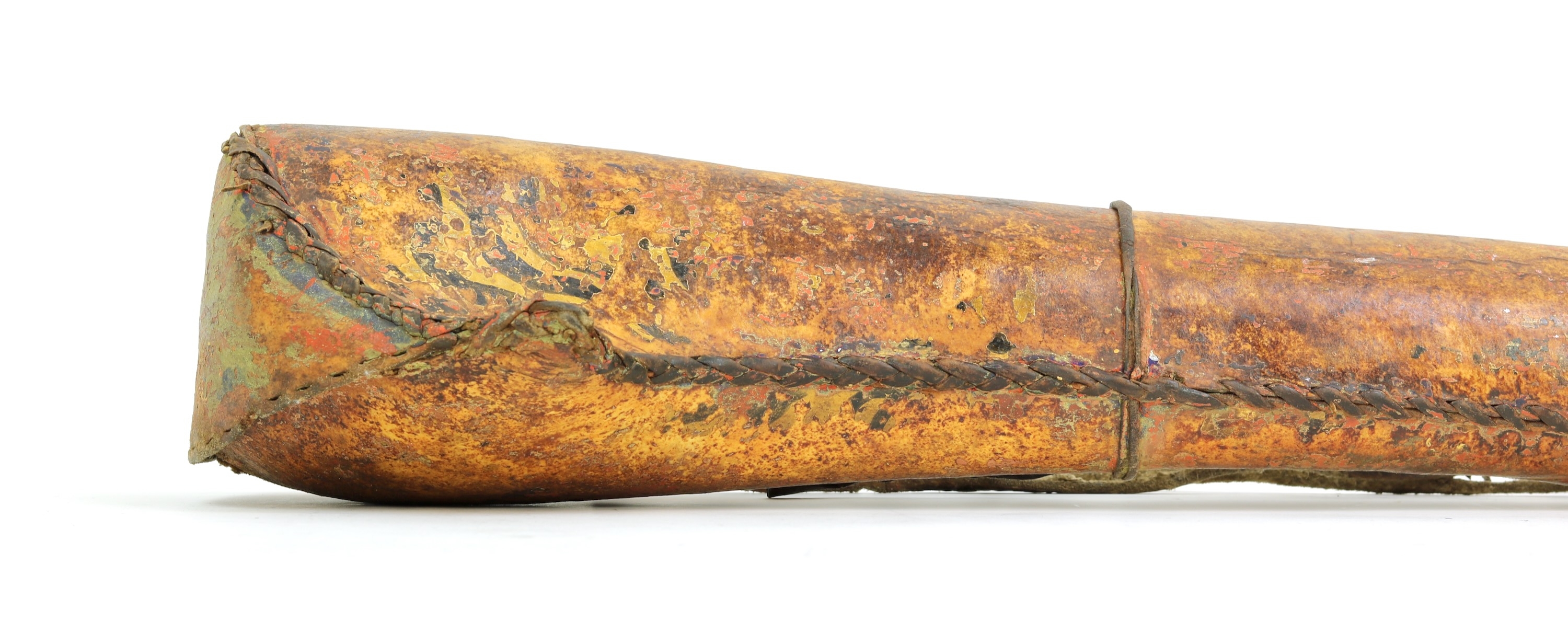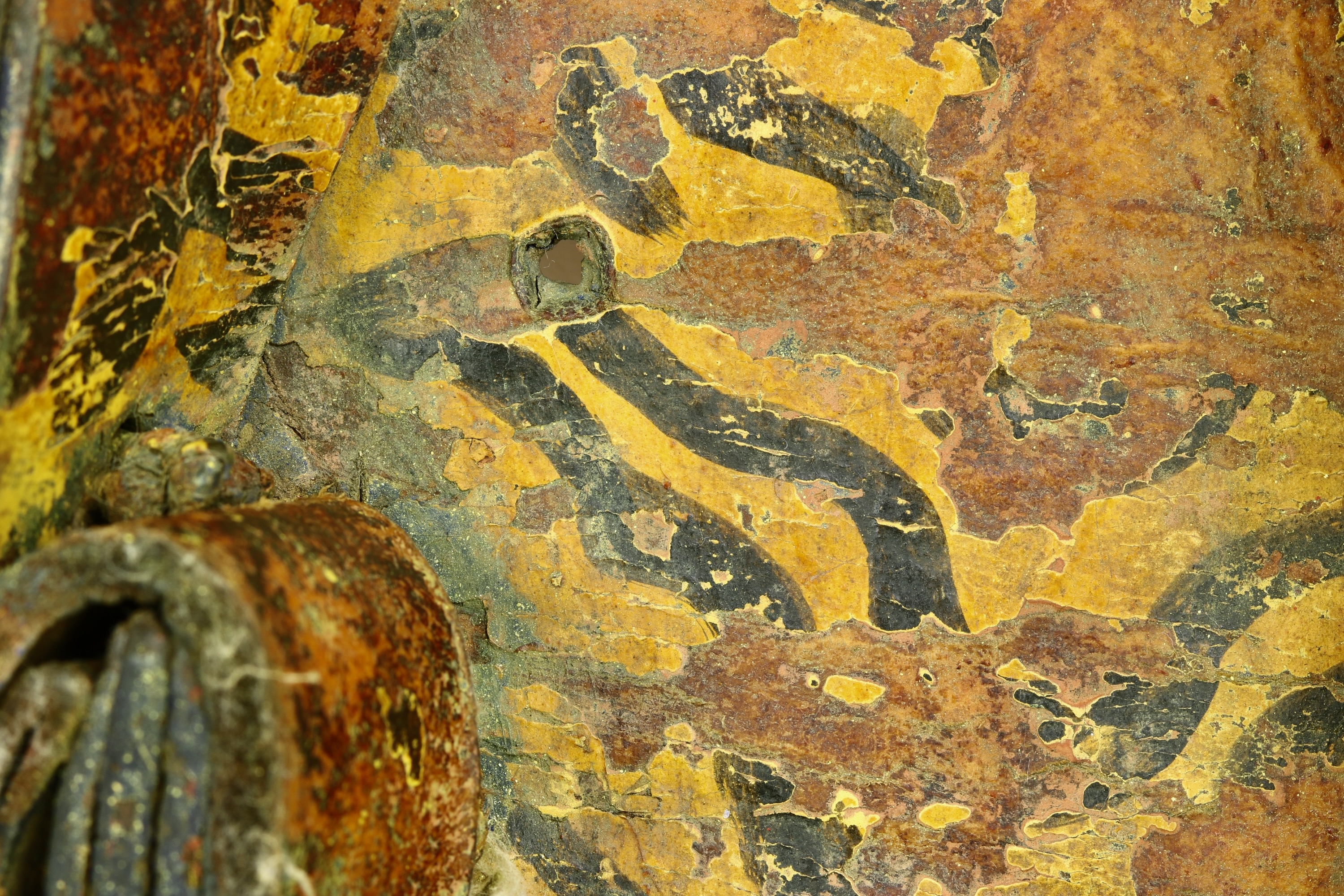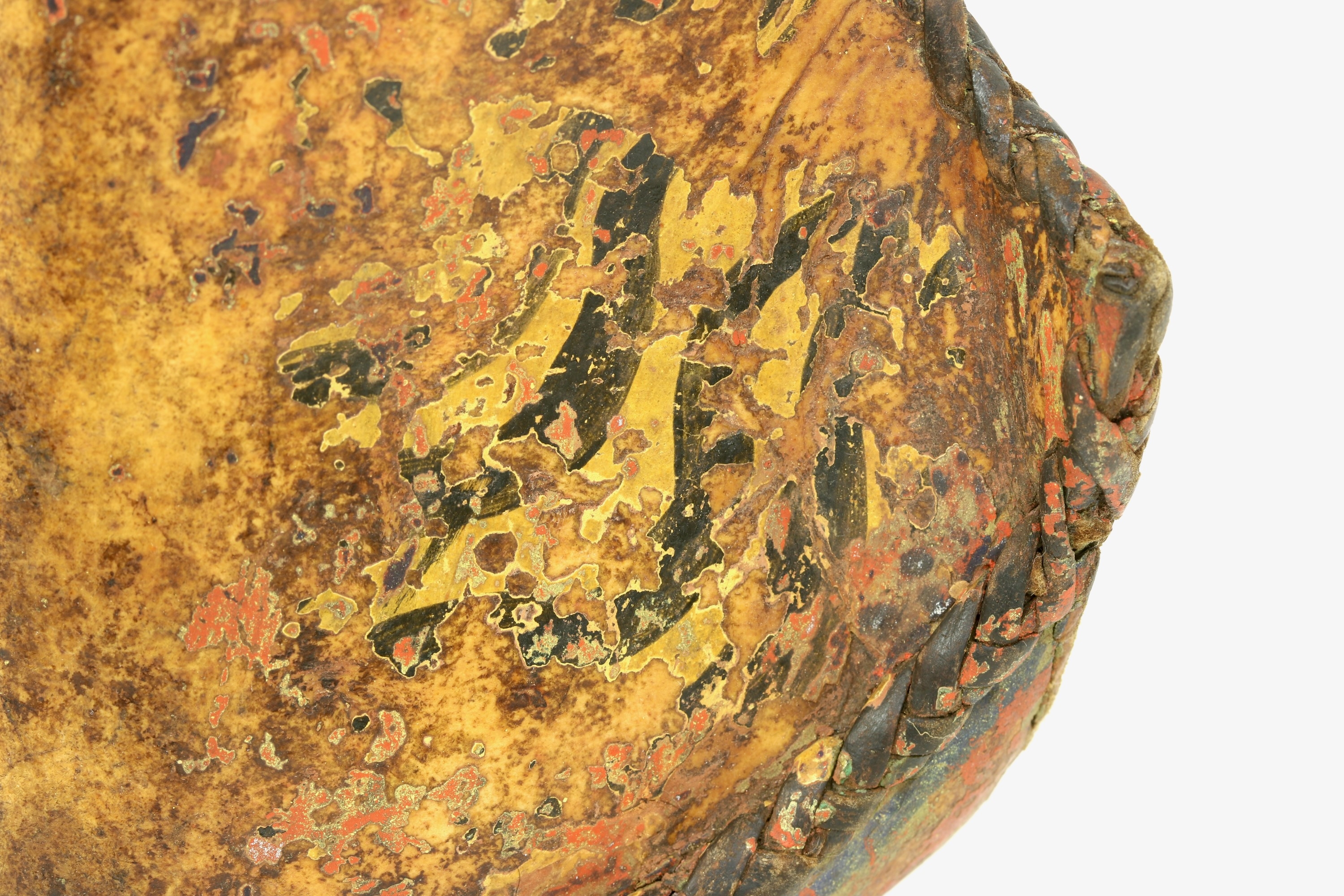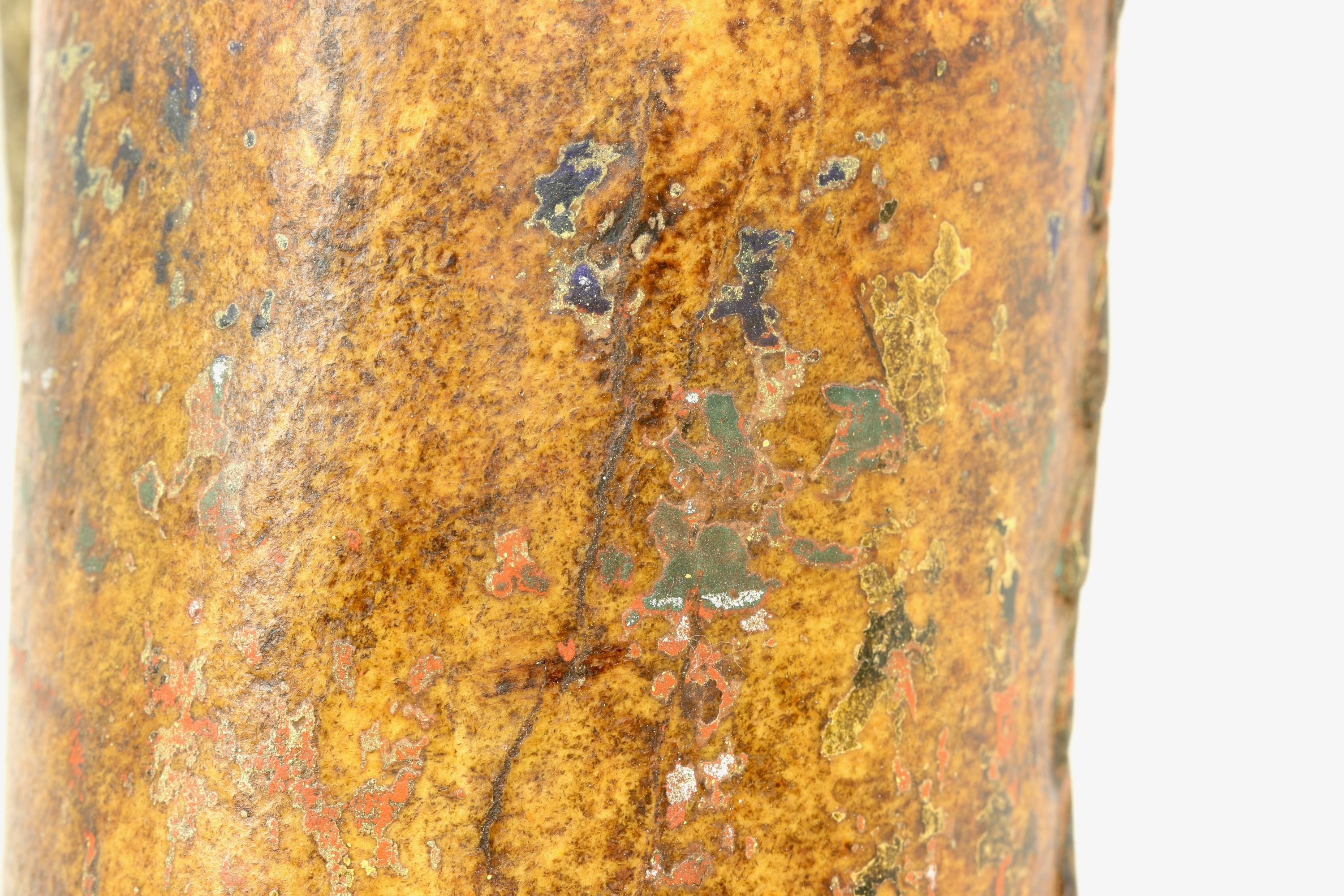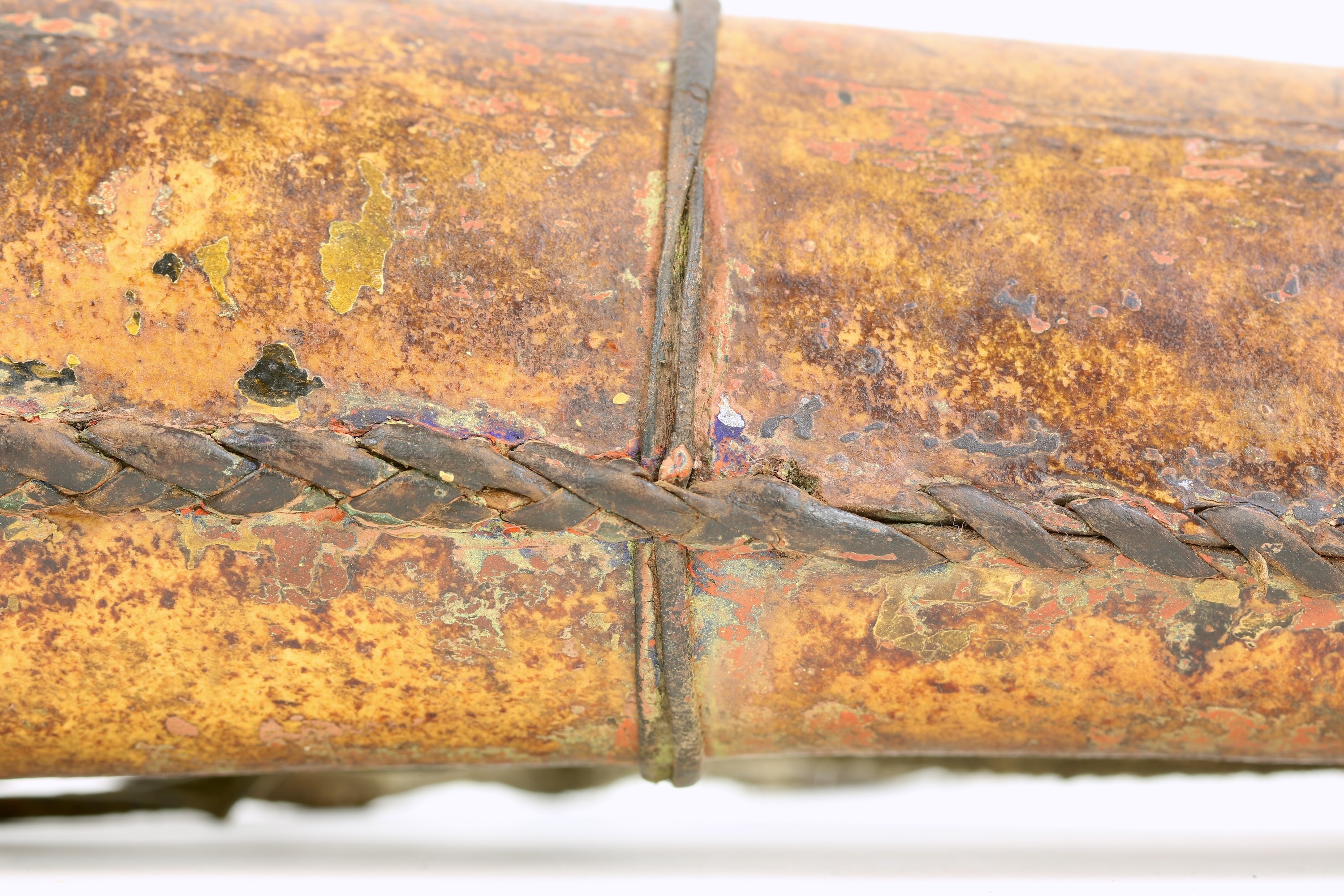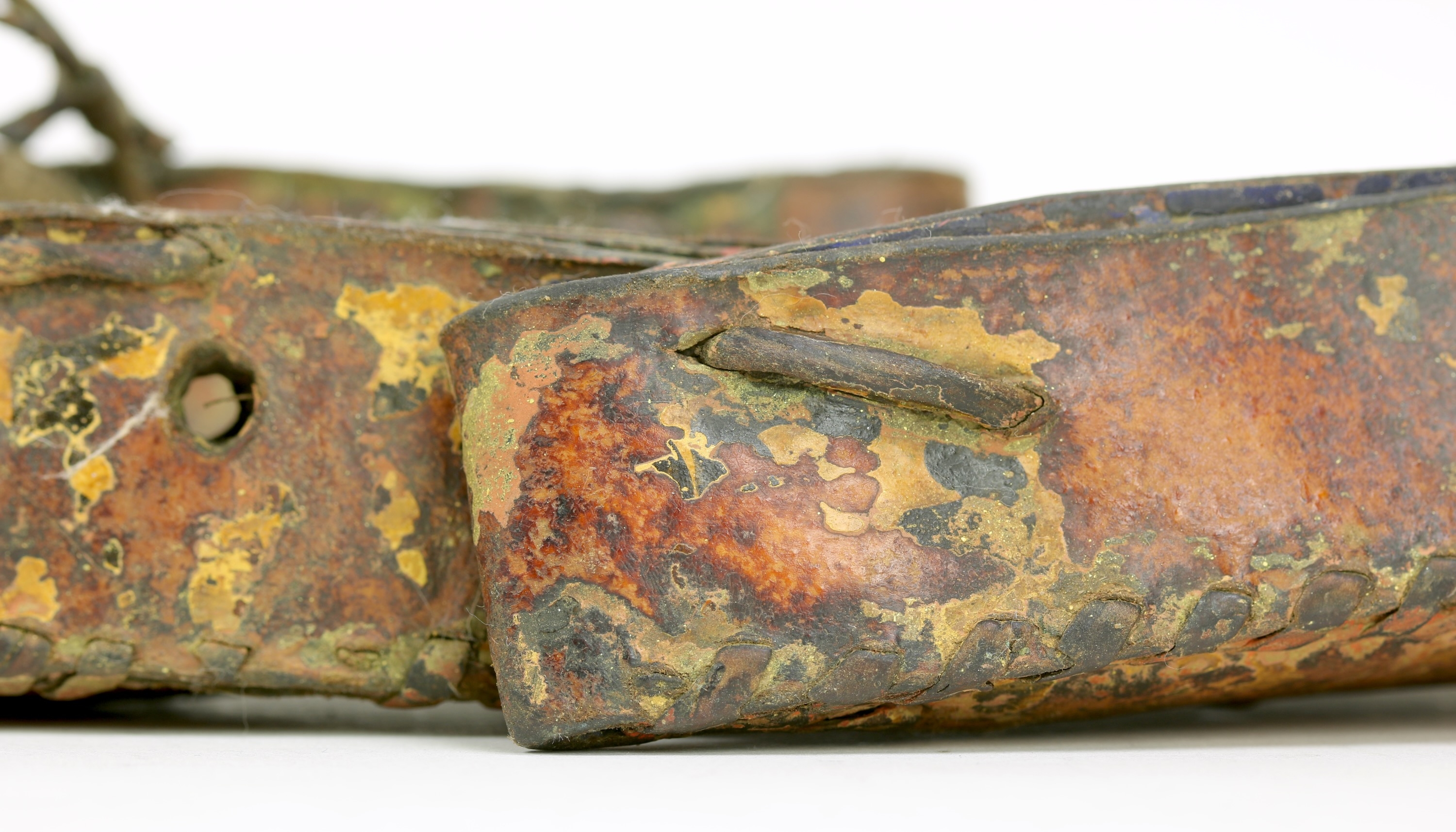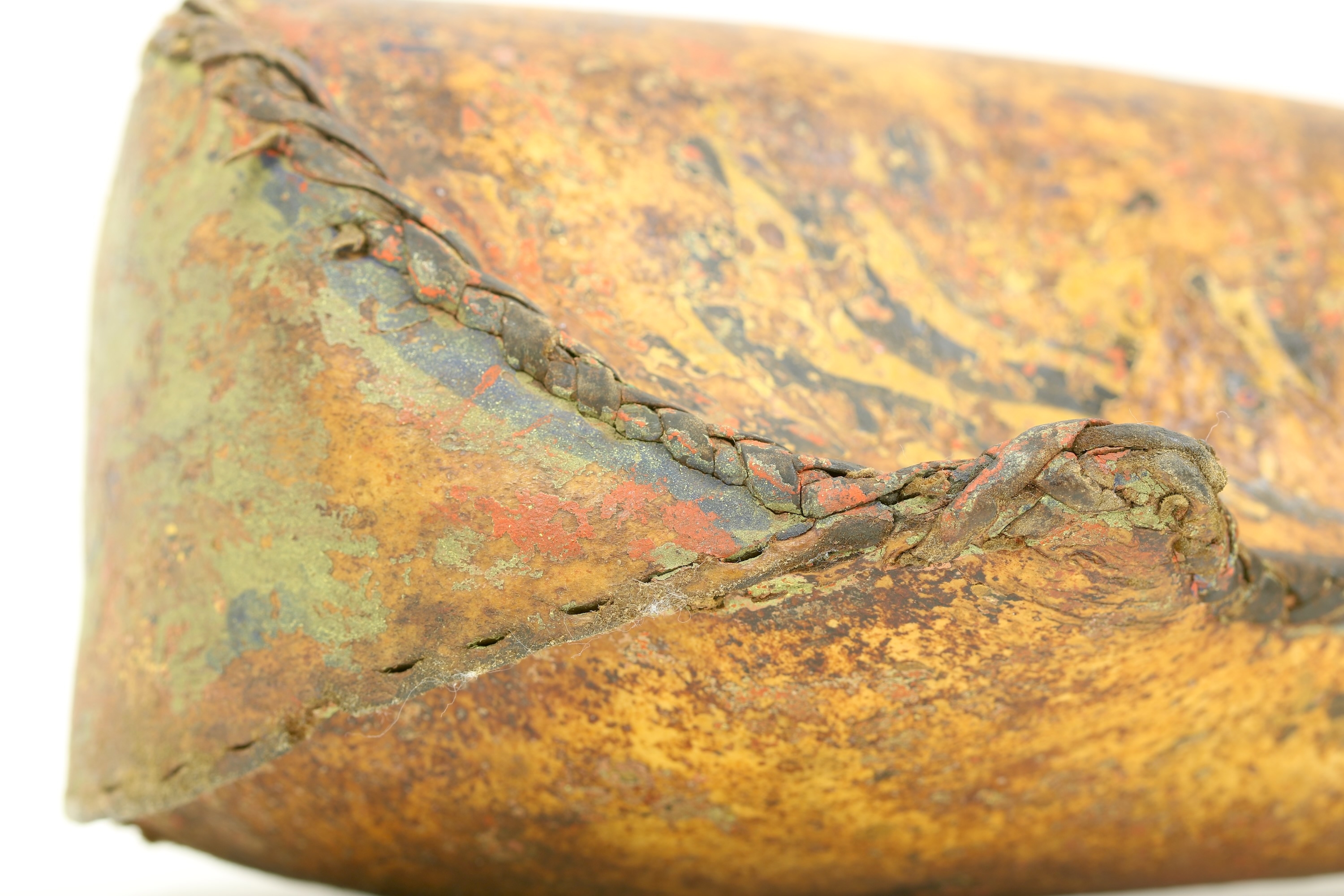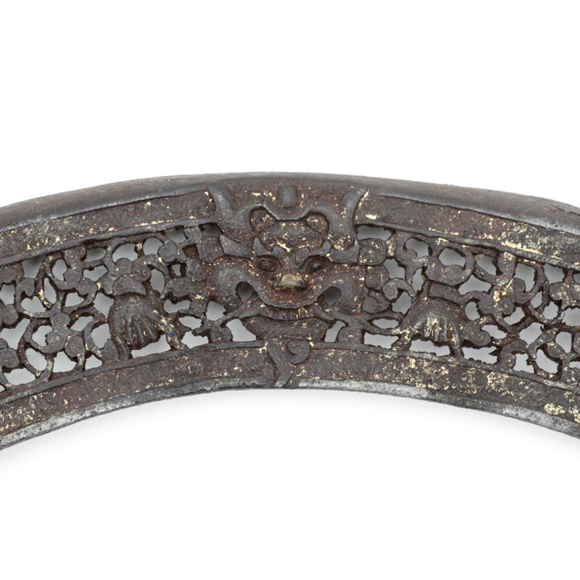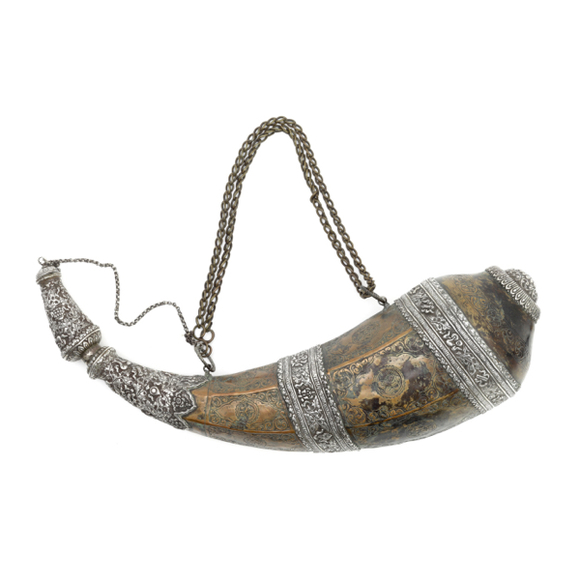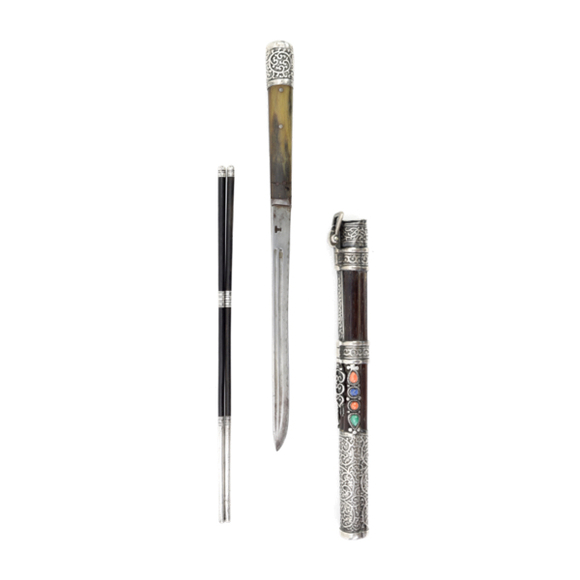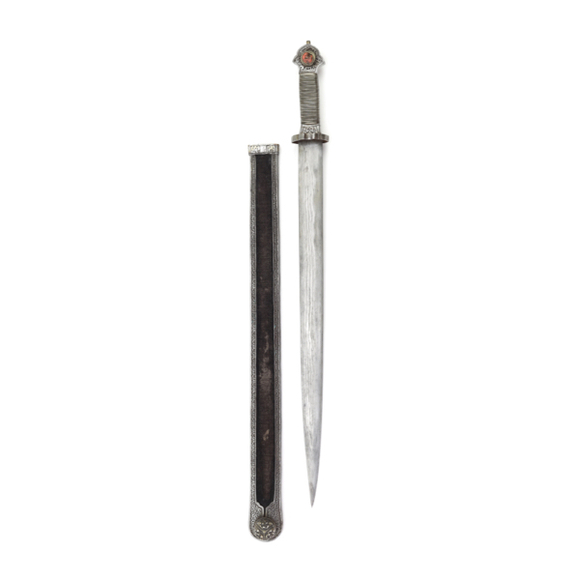This kind of fine work is typical for Tibetan work of the 15th-16th centuries.
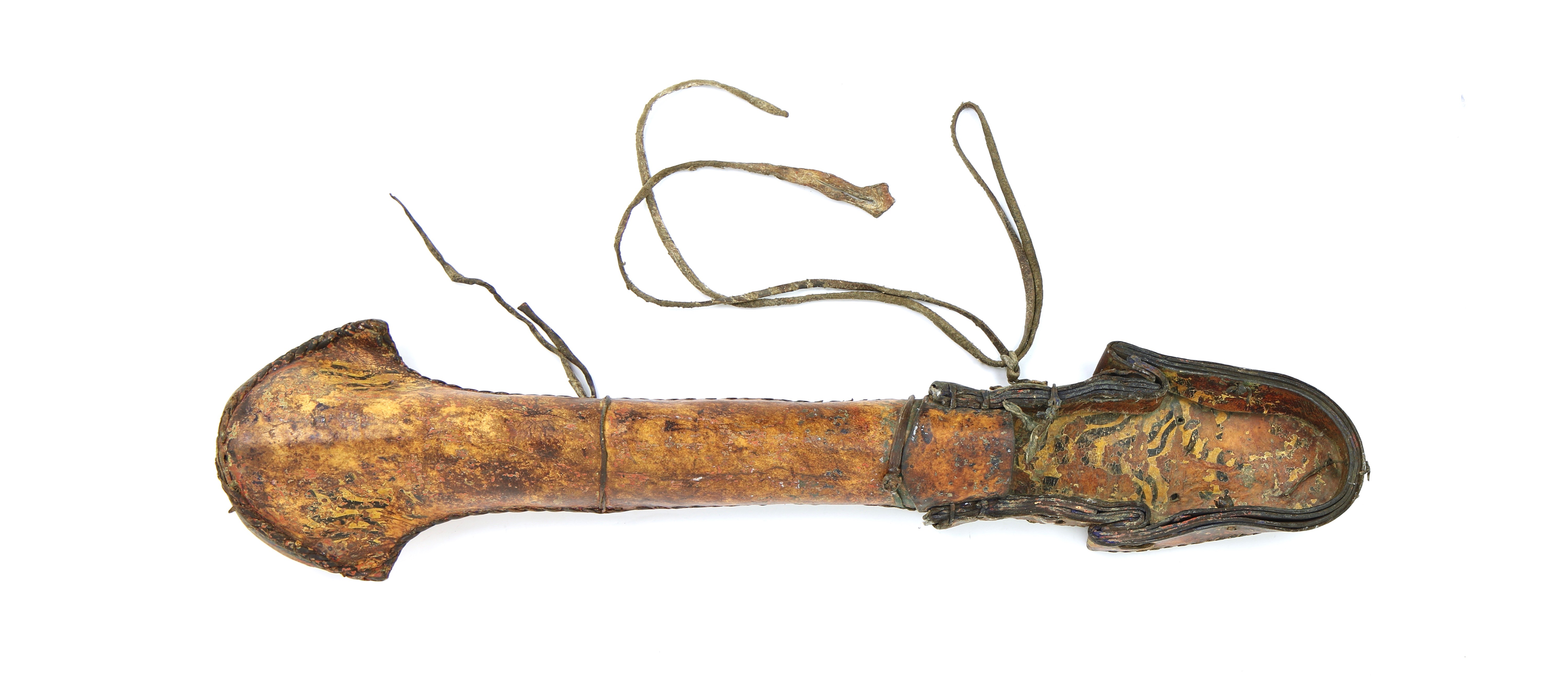
78.5 cm
Length 53.5 cm
Widest at bottom 18 cm
Thickest at bottom 10 cm
Leather, gut, remains of pigment and lacquer
Mongolian or Tibetan
Carbon dated to 1175-1275 A.D.
(95,4% certainty)
Hong Kong based private collection
Introduction
These closed quivers are an early type of arrow quiver used by horse-mounted archers from antiquity all the way up to at least the 15th century. Arrows were carried with the points up in these quivers, so the archer could feel which kind of arrow he was grasping. They gradually fell out of use from around the 13th century onwards. Here we have a very rare example of a type of early Mongolian all-leather tube quiver.
Carbon dating put its manufacture between 1175-1275 A.D. with 95,4% certainty. To put these dates into perspective;
Circa 1167; the birth of Ghengis Khan.
Circa 1175; the birth of Subodai. Ghengis Khan's greatest general and one of the greatest commanders in history.
1184–1206; Ghengis Khan unites the Mongol federations and is formally proclaimed ruler of all Mongols in 1206.
1223; Battle of the Kalka River. Jebe and Subotei lead a decisive Mongol victory against Rus army, annihilating it.
1227; Mongol armies destroy the Tangut Western Xia empire.
1227; Death of Ghengis Khan.
1229; Ögedei Khan, son of Ghengis, takes over Mongol rule.
1234; Mongol armies defeat the powerful Jurchen Jin dynasty.
1237-1240; Mongol Conquest of Russia.
1240-1241; Invasion of Tibet
1241; Invasion of Europe. Famous battles of Legnica and Mohi.
1241; Death of Ögedei Khan. Mongol forces halt the European conquest.
1245; Pope Innocent writes a letter of appeal to the Mongols.
1246; Güyük Khan becomes 3rd emperor of the Mongol Empire.
1251; Möngke Khan becomes 4th emperor of the Mongol Empire.
1258; Invasion of Baghdad, decisive Mongol victory under Hulagu.
1260; Kublai Khan becomes 5th emperor of the Mongol Empire. Proclaimed the Yuan dynasty, under which he ruled China until his death in 1294.
1260; Invasion of Korea.
1277-1287; Invasion of Burma.
1273; Punitive expedition of Korea brings it under tighter control.
1274; First failed invasion of Japan.
1281; Second failed invasion of Japan.
1284; Invasion of Cambodia.
1279; Mongol armies defeat the powerful Chinese Song dynasty.
1293; Punitive expedition to Java. Mongol defeat but Java became a vassal nonetheless.
1294; Death of Kublai Khan
This example
A very rare closed quiver in the Tibetan / Mongolian style, carbon-dated to the height of the Mongol conquest period.
It is constructed out of separate pieces of leather that are sewn together with strips of leather. It consists out of a bottom half, front and back of the tube, and a collar piece covering the last section of the tube. The cowl on top consists of many narrow strips of leather, four layers thick in most places but overlapping at the fold.
It was suspended at the right hip by means of leather straps that are attached to two leather loops that go around the quiver's tube.
The entire piece seems to have once been elaborately decorated. There are remains of black, ochre, cinnabar red, silver powder, and bright oranges and a deep purplish-blue. This is possibly based on lapis lazuli pigments that, for long, were only found in Afghanistan and exported to many parts of the world.
The inside, back, and sides of the cawl, as well as the bottom part of the tube, show the black and ochre used to mimic tiger stripes. Such motifs are relatively common occurrences of Tibetan quivers of the 19th century, see an example from the Richard Wagner collection, sold at Bonhams in 2015.
No other quivers of this early type are known with remains of such an array of colors, nor with tiger stripes, but it goes to show that this tradition goes quite a way back.
Carbon dating results
A sample taken from the inside of the tube was recently sent for carbon dating.
It gave a result of 815,30 years BP (before present), which after calibration comes out at 1175-1275 A.D. with 95,4% certainty. The remaining 4.6% probability lies between 1150-1174 and 1276-1290 A.D.
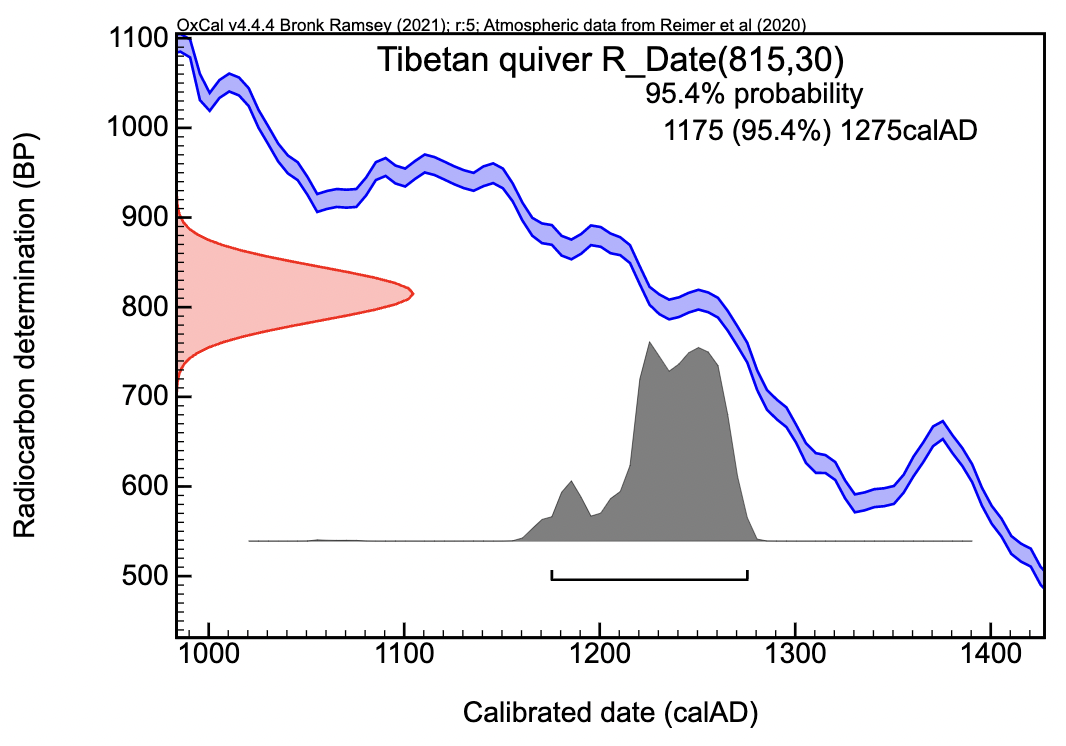
For the geeks: The OxCal calibration graph showing:
Red: the 815,30 BP and its expected range.
Blue: the changes in atmospheric radioactivity.
The date range is determined by where red would intersect with the blue calibration line.
Because atmospheric radioactivity fluctuates over time, the blue calibration line is somewhat irregular. The dating accuracy depends on the shape of the blue line at the intersection, where a steep line gives a smaller possible date range.
The intersection is shown in grey below, where higher means more probably. It also indicates that if all data is correct, the piece cannot date from before 1150 A.D., nor later than 1290 A.D.
Comparable examples
These quivers are exceedingly rare, and as such, there are hardly any comparable examples.
There is one in the Royal Armories in Leeds, accession number XXVIB.141. It is of a somewhat more sophisticated and possibly later design. Typical for these is that they tend to be put together using a fine braid of green leather strips and are finely decorated with black lines on a reddish brown background.1
Another is in the Metropolitan Museum in New York, accession number 2014.71. This is closer to the example currently discussed, in that it is put together with a more simple leather braid, and that the cowl is rather thick and made up of four layers of thick leather strips.
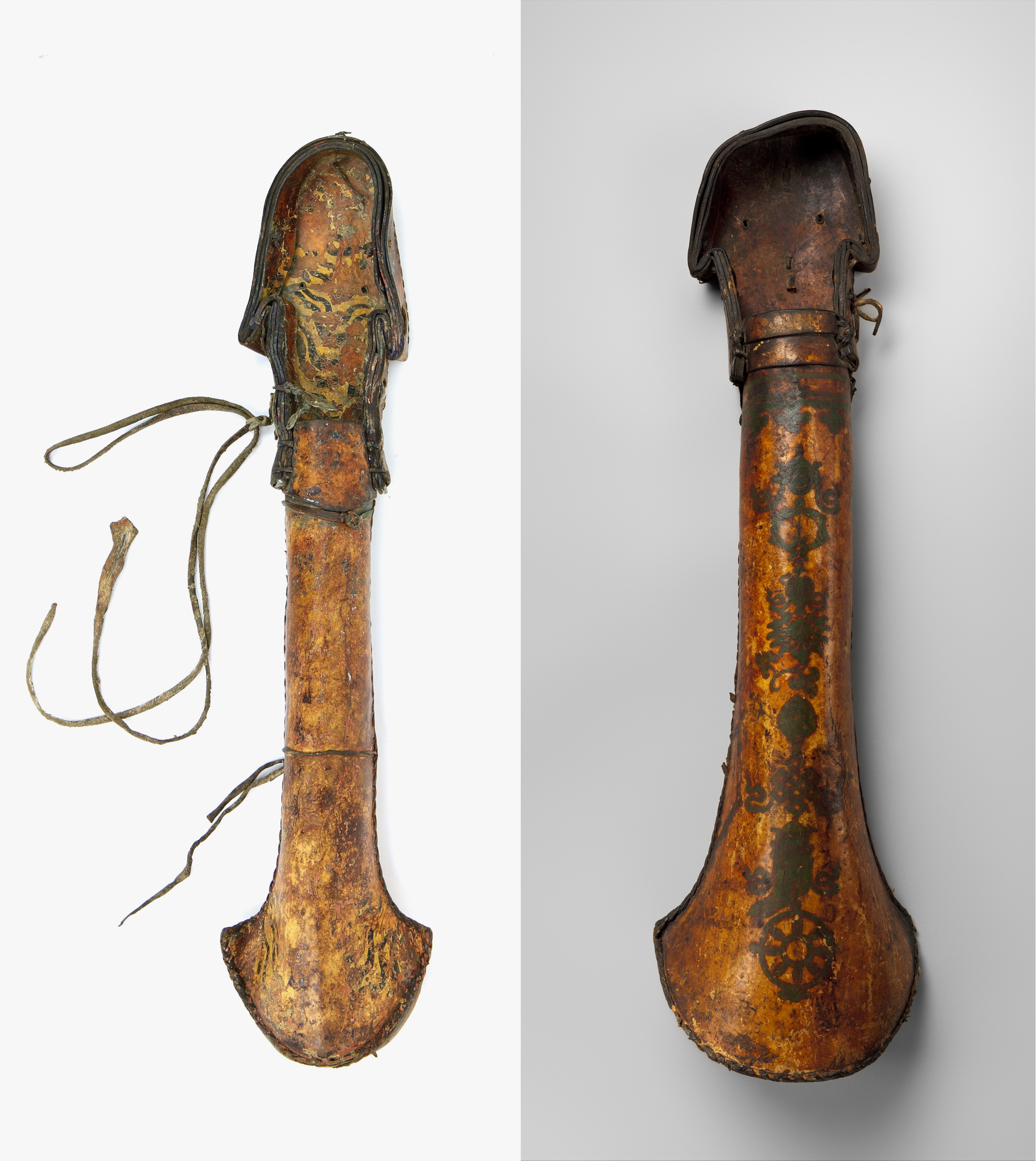
Comparison of the two. Left our current example.
Right, Metropolitan Museum accession number 2014.71.
Conclusion
An interesting and unusual example of what is already a very rare type of quiver. The decoration of the Metropolitan Museum's example puts it in either the Tibetan or Mongolian culture.
Radiocarbon dating put the piece between 1150 - 1290 A.D., with a 95.4% probability of dating from between 1175-1275 A.D., during the life and times of no less than Ghengis Khan.
Notes
1. Donald J. Larocca; Warriors of the Himalayas; Rediscovering the Arms and Armor of Tibet. The Metropolitan Museum of Art, New York. Yale University Press, New Haven and London. Page 190.
